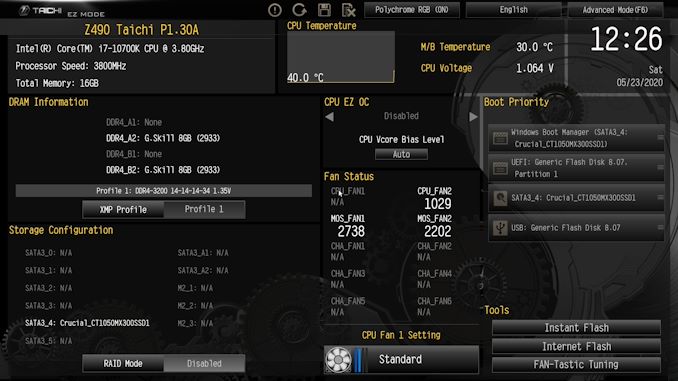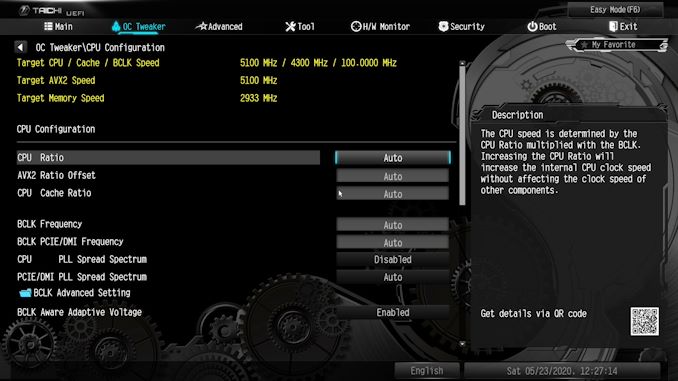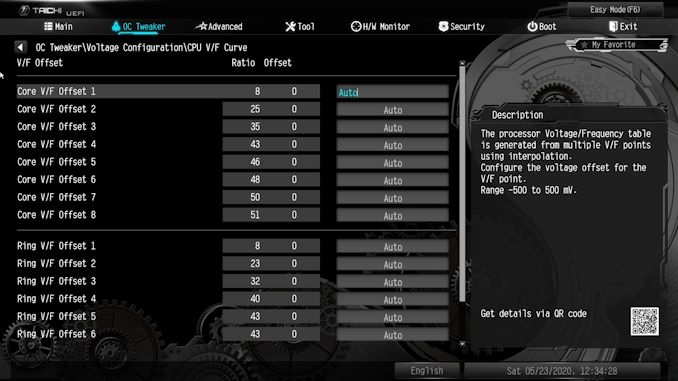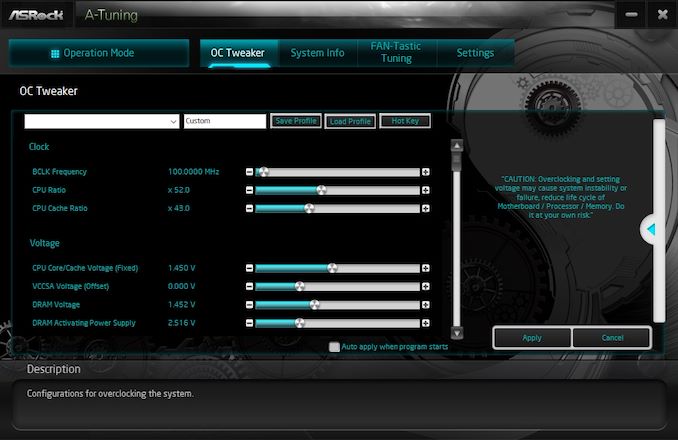The ASRock Z490 Taichi Motherboard Review: Punching LGA1200 Into Life
by Gavin Bonshor on May 27, 2020 9:00 AM ESTBIOS
The firmware on the Z490 Taichi is very similar to what we've seen previously from ASRock, including in our ASRock Z390 Taichi review. The main difference comes in the GUI with a cleaner and more aesthetically pleasing look. It includes a black background with an ASRock Taichi cogwheel inspired logo on the right-hand side. The ASRock firmware is using which text with grey highlights, including a sky blue highlight along the top menu when navigating around various areas of the BIOS.

Note we tested performance with the latest version 1.50, there were no visual differences
The ASRock Z490 Taichi firmware has two primary modes, basic and advanced. The basic screen allows users to view basic information in regards to installed hardware including the CPU, memory, storage, and cooling fans. Users can make basic customizations including enabling XMP 2.0 memory profiles or selecting one of ASRock's CPU overclocking profiles.
Along the top, there are eight different menus including the OC Tweaker, Advanced menu options and tools menu including ASRock's Polychrome RGB software which has a very user-friendly GUI. The H/W Monitor section allows users to view temperature information for a plethora of sensors within the CPU and around the board, as well as fan speed information. This section also includes ASRock's FAN-Tastic Tuning utility where users can set custom fan profiles, or allow the firmware to do the work via optimization.
Within the OC Tweaker menu, users can overclock both the CPU and memory, as well as the integrated graphics on Intel's Comet Lake desktop processors which feature it. ASRock has included a wide array of options for overclocking the CPU including core frequency control, ring frequency and for users who wish to do so, base-clock (BCLK) frequency. There is also a wide variety of memory overclocking options including frequency, latencies, and the ability to enable and disable XMP 2.0 profiles on memory kits that are supported. Further in the OC Tweaker is a dedicated section for voltage control, with a lot of voltages the regular user wouldn't need to touch. Finally, the OC Tweaker includes Intel V/F curve controls for users looking to leverage the technology for better control over turbo speeds.
Overall the firmware on the ASRock Z490 Taichi is easy to navigate and has a large collection of customizable settings for tweakers and overclockers to play with. Using the firmware which came preinstalled onto the board (1.30), it was a little laggy and unresponsive sometimes. This issue was fixed when it was flashed to the latest version at the time of testing (1.50). ASRock is good at organizing sections within the firmware with individual sections for CPU, memory, and voltage settings within the OC Tweaker menu. There is also plenty of memory latency timing customization which is good as the memory controller on Intel's Comet Lake seems to be stronger than previous generations.
Software
Supplied with the ASRock Z490 Taichi is an adequate and unassuming selection of software utilities which is spearheaded by its A-Tuning software which allows users to overclock and tweak within Windows. Also included is ASRock's Polychrome RGB software, ASRock's advertisement and gambling ridden Live Update and App Shop application, as well as a Dragon 2.5 G utility for traffic shaping.
The most prominent piece of software supplied with the ASRock Z490 Taichi is the A-Tuning utility. This allows users to overclock the CPU and base-clock within Windows, as well as make voltage adjustments in real-time. There are three preset modes, performance mode which mirrors Window's own power plan when in high-performance mode, while both standard mode and power-saving have less aggressive settings.
ASRock's software suite which is included with the accessories bundle, or via the official product page on the ASRock website, is more than enough without diluting it down. The ASRock Polychrome RGB utility allows users to turn a system into a mobile disco, while the Restart to UEFI software allows users to enter the BIOS upon the next boot, which is really handy if you're not quick enough at spamming the F2 key. The Live Update and App software offers some functionality with a handy software and driver update tool.

























57 Comments
View All Comments
lmcd - Wednesday, May 27, 2020 - link
Honestly this is the most inane post I've ever read. Times haven't changed for the better, Raven Ridge support took over a year after the SoC was released. I own two Raven Ridge devices. I would know.Even when AMD support hits mainline, it's in such a late kernel version that you better hope this "sane" distro you're referring to is willing to backport support in an update.
Dunno what you mean about the Nvidia driver being painless to use. Its Wayland support is still comparatively unstable in Gnome and pushes KDE Wayland support from mediocre to bad. It also requires extra build tools.
I can't edit posts but I explained a key usage of nested Hyper-V. "Anyone who wants to use the Windows 10X emulator needs it unfortunately." There's also plenty of other features that use Hyper-V these days from WSL2 to Windows Sandbox, so the antiquated views on Hyper-V are also quite dated. Times have changed for the better, and Hyper-V is very much part of the present.
Congrats on your condescension though! It almost masks how wrong you are.
Dug - Wednesday, May 27, 2020 - link
Why in the world do you insist on benchmarking Non-UEFI POST Time when no one will use that?TheinsanegamerN - Thursday, May 28, 2020 - link
Because not everyone is you and there are those of us that DO use it. Wow, what an amazing thought.Dorkaman - Thursday, May 28, 2020 - link
I would love to see UEFI post time AND Windpows clean knstall boot time. My old Asus Rampage V Extreme was very slow (40s post+boot no mem test hybrid) and the new Asus ROG Maximus XII Extreme is also very slow.My Gigabyte Z390 Aorus Master posts+boots in 10+5 seconds.
Dug - Wednesday, June 3, 2020 - link
Why would you be buying new equipment for outdated OS's that aren't supported?If that's the case, the boot time is irrelevant, and my post still stands. Why even bother benchmarking it?
Ranger1065 - Wednesday, May 27, 2020 - link
A good read, always a pleasure to peruse Anandtech. The aesthetics are not for everyone but personally I think it's a nice looking board. Out of my price range but Z490 is not for me anyway. As to Asus boards, I have an older Z97 Maximus Hero VII and a Z390 Prime. Both great boards that have given me no significant issues.Jorgp2 - Wednesday, May 27, 2020 - link
Do the new CPUs have an additional 4x lanes from the CPU?I keep seeing boards that advertise 8,8,4 slots, with all of them coming from the CPU. And this motherboard for example that has the 4x gen 4 M.2, when the chipset does not have Gen 4
MDD1963 - Wednesday, May 27, 2020 - link
The specs I read said the top GPU slot would be capable of PCI-e 4.0 x16, ...and one of the M.2 slots...( perhaps I missed where it said all 4 might be capable fo PCI-e 4.0 x4 operation?_)Even with the aforementioned limits, more than enough for 99% of most folks....
Spunjji - Thursday, May 28, 2020 - link
Waiting to see how many people show up to the comments to wail about the tiny fans. After all, it wasn't anti-AMD sentiment that caused so many folks to show to all of the articles related to X570 boards (and a few that weren't) and do that, it was totally neutral concerns about longevity and noise.(Full disclosure - I am fully on-board with not wanting tiny fans on a motherboard... just feeling a little amused by the asymmetry of this. The only comment here so far on this topic has been a sensible one, not hysterical ranting.)
TheinsanegamerN - Thursday, May 28, 2020 - link
So you smugly, disingenuously re-categorize the arguments of others and think you're...clever? Funny? Intelligent?Now, here's points for asrock that might blow your mind, these are STANDARD FANS. You can go buy brand new noctuas to replace these and silence them while maintaining cooling performance. Guess what you couldnt do with x570 chipset fans? These fans also dont spin 24/7, only when needed, and the VRMs here get a LOT hotter then the x570 chipset did.
If X570 got into the 90C range without the active cooling (it doesnt) and they used standard 40mm fans (they dont) then the complaints would be baseless. But we saw how necessary those x570 fans really were. And oh hey, there are plenty of Z490 mtoherboards that dont use VRM fans! Just like that whole 1 X570 motherboard that cost like $700!